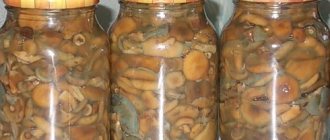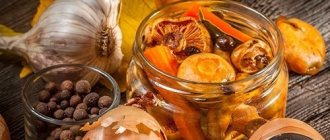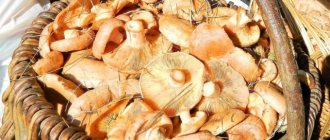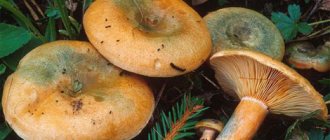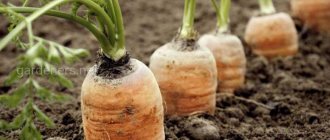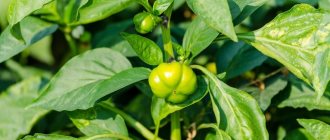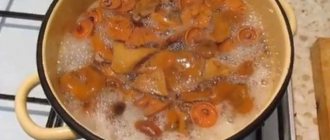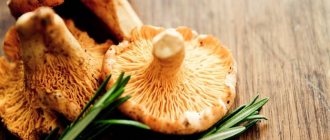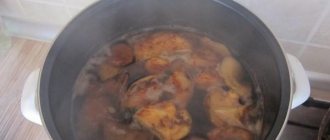Many lovers of “quiet hunting” are sure that saffron milk caps are excellent for preparing for the winter as pickling.
These mushrooms are not only pleasant to collect, because they grow in large groups, but also to carry out primary processing. The pulp of saffron milk caps has a juice that is not at all bitter, so they are practically not soaked, but only washed in plenty of water. The stems of the mushrooms are quite thick; they can be salted together with the caps, which is not done with other types of mushrooms. Although all types of saffron milk caps are included among the best candidates for salting, pine and spruce mushrooms are still singled out.
How to tell if canned mushrooms have gone sour
As for how to identify a sour twist with mushrooms, everything is a little simpler here. At the initial stages, as a rule, no signs of damage are observed, but later they become quite bright.
- Usually, a swollen lid and cloudy marinade indicate that the product has soured.
- Foam forms in the upper part of the workpiece, which subsequently turns into mold and grows first at the top and then falls below. E
- Another sign of a spoiled product is an unpleasant sour smell emanating from the contents of the jar. But to find it, the container will have to be opened.
If you think the twist has gone bad, get rid of it immediately, as eating such a product will inevitably lead to severe food poisoning.
How to tell if canned mushrooms have gone sour
Express method for pickling saffron milk caps
Cooking time: 25 minutes
Number of servings: 15
Energy value of the product
- calorie content – 16.8 kcal;
- proteins – 1.9 g;
- fats – 0.8 g;
- carbohydrates – 0.5 g.
Ingredients
- saffron milk caps – 1.5 kg;
- table salt – 60 g.
Step-by-step preparation
- We carefully sort through the saffron milk caps, rejecting damaged specimens and removing all excess debris, carefully cutting off the ends of the stems, cleaning the caps with a soft brush to remove dirt, and thoroughly rinsing the mushrooms under a running stream, after which we dry them with paper towels.
- We transfer the product prepared in this way into layers into a clean glass container with the plates facing up, generously filling each level with table salt, and, covering it with a nylon lid, leave to infuse.
- As soon as the brown brine appears in the appetizer, let the saffron milk caps stand for another hour and a half and serve them to the table. The main thing to remember is that mushrooms prepared using this method will not be stored for a long time and it is advisable to quickly eat them.
What you need to know about barrels?
- The rivets for them can be sawn or chipped. It is believed that barrels made from split planks are better because the splitting technology preserves the structure of the wood.
- Wine barrels are fired so that the wood releases extractive substances more actively. They add greater richness and depth to the wine, but can distort and even ruin the taste of vegetables, so unfired containers are used for pickling.
- It is best to choose barrels with hoops made of stainless or galvanized steel. They are not afraid of moisture, which is always sufficient during preparation.
- It is better to salt colored vegetables in oak barrels. Natural tannins, which oak is so rich in, have an antiseptic effect and give them a richer color. Simply put, vegetables become a little darker in oak barrels. This does not decorate cabbage and apples.
Tubs
The bottom diameter of the tub may be larger than the top diameter. In most cases, the container has the shape of a truncated cone. It has smooth walls, without expansion in the middle part.
The tubs are made from oak, aspen, cedar, and linden. To make a tub, they take special chipped boards called rivets.
The tubs are stored only vertically, they cannot be placed on their side. Often the tub has a loose lid, not ground in, with one or two handles. The planks for the tub are connected with hoops.
The tub is better suited for pickling than a barrel due to its shape
What you need to know about tubs
The properties of the tub largely depend on the material from which it is made.
- Oak tubs have an additional antibacterial effect and prevent the formation of mold. But light vegetables can darken in them. But they are excellent for pickling cucumbers or tomatoes. In oak containers you can prepare not only vegetables, but also fish, meat, and lard. Oak is the most common material for planters.
- Linden tubs have a faint floral aroma and do not emit coloring substances. Therefore, it is ideal to pickle cabbage and apples in them, to prepare fruits and mushrooms. They also store honey, which improves its taste in this container due to its aroma.
- Cedar tubs have pronounced antibacterial properties. Pickles are stored in them longer, since the substances released by cedar wood inhibit bacterial activity. Tubs made of this material are quite rare.
- Aspen tubs have neutral organoleptic properties, so the vegetables in them retain their natural taste, thanks to the natural preservatives contained in the wood. The best option for pickling cabbage is an aspen tub. In it, the vegetable retains its color, elasticity and taste. In past times, housewives specially placed aspen logs at the bottom of a tub made of another material to make the cabbage tight and juicy. Aspen is easily soaked, after which the rivets form a single structure - the seams between them become practically invisible.
Table. Comparison of tubs and barrels for pickling
| Parameter | Barrel | Tub |
| Walls | convex | smooth |
| Bottom and top diameter | same | mostly different, bottom larger than top |
| Material of manufacture | oak | oak, aspen, linden, cedar |
| Fastening | hoops | hoops |
| Position | vertical | vertical |
| Volume (common) | From 5 to 50 l | From 1 to 30 l |
A barrel differs from a tub in shape and material of manufacture
Hot salted saffron milk caps (step by step)
Hot salting differs from the cold recipe in that the saffron milk caps are boiled a little beforehand.
You will need:
- Camelina mushrooms.
- Salt.
- Garlic.
- Mustard seeds, dill, bay leaf.
Step by step recipe:
Clean the mushrooms from debris, rinse, and cut off the stems. Divide large caps into 2-4 parts to make it easier to eat. Place in a bowl.
Pour water into the pan, wait until it almost boils, add the mushroom preparations. The temperature of the water in the pan should be approximately 90 o C, do not let it boil.
Stir the cuts and now let the liquid boil. Blanch the mushrooms for a couple of minutes, skimming off the foam along the way. There is no need to salt the water.
Catch the saffron milk caps with a slotted spoon, or simply drain the broth. Rinse them under running water. Let cool.
Start placing the mushrooms in the pickling container. Make an even, not thick layer, caps down. Place chopped garlic cloves on top. Determine the amount of garlic yourself (the less, the milder the taste of the mushrooms).
Salt generously. Don’t be afraid to over-salt; in the case of saffron milk caps, this is difficult to do. Scatter the broken bay leaves and seasoning grains over the surface of the layer.
And lay the next layer of mushrooms. Continue until the harvest is over.
Cover with gauze, place a plate on top and press down with pressure. The saffron milk caps will be salted after 3-4 weeks.
More ways to pickle milk mushrooms
Dry salting of milk mushrooms
Ingredients:
- Milk mushrooms – 10 kg
- salt – 500 g.
Peel and disassemble the mushrooms, cut off the stem, place in a wooden barrel, sprinkle with salt, cover with a napkin, place a circle and a weight on top. Pickled mushrooms, separating their juice, noticeably thicken. As they settle, you can add fresh triba, sprinkling them with salt until the dish is full and the settling stops. Mushrooms are ready to eat after 35 days.
Salting boiled milk mushrooms
For 10 kg of boiled milk mushrooms:
- 450–600 g salt
- garlic
- onion
- horseradish
- tarragon or dill stems
Clean and washed mushrooms are boiled in lightly salted water. The cooking time depends on the type of mushroom. Cool in cold water. Allow the water to drain on a sieve. Then the mushrooms are placed in a barrel, mixed with salt, covered with a cloth and a lid with pressure. After a few days, the mushrooms will settle and you need to add more mushrooms with the appropriate amount of salt.
Seasonings are placed at the bottom of the dish or mixed with mushrooms. After a week they become suitable for consumption. The brine must completely cover the mushrooms throughout the storage period to avoid mold. If there is not enough brine and it does not cover the mushrooms, you should add chilled salted boiled water (take 50 g, i.e. 2 tablespoons of salt per 1 liter of water). During storage, mushrooms should be checked from time to time and mold should be removed. The lid, oppression stone and fabric are washed from mold in soda water and boiled, the inner edge of the dish is wiped with a napkin moistened with a solution of salt or vinegar.
Salting milk mushrooms and milk mushrooms in Altai style
Ingredients:
- mushrooms – 10 kg
- dill greens – 35 g
- horseradish root – 20 g
- garlic – 40 g
- allspice – 35–40 peas
- bay leaf – 10 sheets
- salt – 400 g.
The mushrooms are sorted, cleaned, the stalk is cut off and soaked in cold water for 2-3 days. The water is changed at least once a day. Then the mushrooms are thrown onto a sieve and placed in a barrel, layered with spices and salt. Cover with a napkin, place a circle and a weight. Brine should appear above the circle. If the brine does not appear within 2 days, it is necessary to increase the load. The barrel is filled with new mushrooms, as the volume of mushrooms gradually decreases by one third. After 20 days, the mushrooms are ready to eat.
Salted blanched milk mushrooms
Ingredients:
- 10 kg mushrooms
- 400–500 g salt (2–2.5 cups)
- garlic
- parsley
- horseradish leaves
- stalks of dill or celery
Blanch the peeled and washed mushrooms. To do this, put them in a colander, pour plenty of boiling water over them, steam them or put them in boiling water for a short time so that the mushrooms become elastic and not brittle. Then cool quickly by pouring cold water. Place in a colander and let the water drain. Place in a prepared wooden tub in layers, sprinkling each layer with salt and topping with garlic, parsley, horseradish leaves, dill and celery. After 3–4 days, the blanched mushrooms are salted and ready for consumption.
How to properly re-salt saffron milk caps if the mushrooms have fermented after salting?
With the hot pickling method, mushrooms can be boiled for 10-15 minutes in salted water or blanched for 3-5 minutes in boiling water. Usually, with this option, mushrooms rarely spoil, as long as the recommendations for pre-cleaning and storage are followed correctly. But what if the saffron milk caps still fermented after salting? In this case, you need to carry out a step-by-step correction of the problem. Drain the brine, pour cold water over the mushrooms and rinse well. Place in a colander and place in boiling water for 2-3 minutes. Place in jars, sprinkle with salt and spices. Pour in cold boiled water, press down to release the air, and close with tight nylon lids. Take to a cool and dark basement, store at a temperature no higher than +10°C. As already mentioned, higher temperatures can cause the mushrooms to ferment. If saffron milk caps have fermented, how to quickly and re-salt them? To increase the speed of re-salting mushrooms, you can use the following option. Wash the mushrooms, boil for 3 minutes in salted water, and rinse again. Place in an enamel pan, sprinkling only with salt, without any spices. Pour hot boiled water and press down with a weight, covering the top with gauze or a cloth napkin. These mushrooms will be ready to eat in 5-8 days. Before serving, they are washed well, seasoned with olive or vegetable oil with the addition of green or onions. There is another reason when saffron milk caps fermented during salting - old specimens of fruiting bodies were used in the preparation. In adulthood, saffron milk caps accumulate many harmful substances and heavy metal salts in their pulp. Therefore, for pickling, it is best to use only young, strong and unspoiled mushrooms, which will minimize the problem of fermentation.
Useful properties of saffron milk caps
Saffron milk caps are distinguished by their bright color, which is provided by the presence of beta-carotene. Once in the blood, it is synthesized into vitamin A (retinol), necessary for good vision.
Their composition is also rich in B vitamins and ascorbic acid, which has a beneficial effect on the immune system. Eating mushrooms helps improve digestion, because... they are rich in fiber and zonal substances.
In folk medicine they are often used to treat various inflammations of a bacterial nature. This is possible thanks to the presence of a natural antibiotic - lactyrioviolin. It naturally inhibits the growth of bacteria and leads to complete recovery of the patient.
The presence of protein (more than 4%) makes these forest products a valuable food product, partially replacing meat.
Salted saffron milk caps: the hot method
Hot pickling of saffron milk caps is a recipe based on heat treatment of the product followed by pickling at home.
Ingredients:
- 10 kg of fresh saffron milk caps;
- 500 gr. table salt (not iodized);
- 15-20 clove buds;
- 100 gr. black currant leaves;
- 3 cloves of garlic;
- 15 peas of allspice;
- 10-15 bay leaves.
Before you pickle saffron milk caps for the winter at home, you need to carefully sort through and discard wormy and spoiled mushrooms. If there is a lot of wormhole, then such a batch should be soaked in slightly salted water for several minutes. If everything is fine, then a regular one will do. After cleaning, cut large specimens into several parts, leaving small ones whole, as required by the recipe.
We put water on the stove; when it boils, add the saffron milk caps. Cook after boiling for up to 5 minutes, regularly skimming off any foam that appears.
Drain properly boiled mushrooms through a sieve and cool to room temperature. Then we fill the container prepared for pickling, placing the saffron milk caps up so that they are salted more evenly. Each layer should be generously salted, seasoned with bay leaf, currant leaves and other spices.
When everything is in place, you need to put pressure on top. A wooden circle or an ordinary shallow plate is suitable for this. In this recipe, the weight can be a heavy clean stone or a three-liter jar of water. Cover the dish with a double layer of gauze and apply pressure.
We place the container for 1.5 months in the cold with a temperature of 0 to +7 degrees Celsius. A basement or cellar is suitable for this; at worst, you can use the bottom shelf of the refrigerator.
A clear temperature indicator at home is the brine, or rather its color. During normal salting of saffron milk caps, the brine always has a brownish color. If it turns black, then the ambient temperature is higher than necessary. In this case, the mushrooms are no longer suitable and there is no point in salting them further.
Target=”_blank”>https://gribnichki.ru/wp-content/uploads/2015/10/52522581-300×229.jpg 300w” width=”720″ />
After a month or two, you can enjoy a delicious snack - salted saffron milk caps, prepared according to this recipe for the winter. Salted saffron milk caps: cold method This method of pickling is good because almost all nutrients, vitamins and minerals are preserved in the final product.
Ingredients:
- 1 kg of saffron milk caps;
- 10 pieces. bay leaves;
- 20 gr. black currant leaves;
- 50 g salt;
- 20 pieces of allspice;
- 2-4 cloves of garlic;
- a little black pepper.
Cold salting of saffron milk caps for the winter is most often used for young mushrooms. We clean the mushrooms properly and rinse them with cold water. Then you need to spread them on a dry towel to drain off excess liquid.
In the meantime, prepare the dishes for pickling the saffron milk caps. An enamel-coated pan, glass jar or wooden barrel is perfect for these purposes. Place spices with bay leaves on the bottom and sprinkle a little salt. Although experienced mushroom pickers make do with only salt, so as not to interrupt the already very rich natural taste and aroma of salted saffron milk caps.
We begin to lay out the mushrooms with their caps up, periodically sprinkling them with salt (you need to salt generously). Salt consumption: 1.5 cups of salt per 1 bucket of raw materials. After this, cover the dish with a circle, cover it with gauze and put pressure on top.
To successfully salt saffron milk caps at home, the ambient temperature should not exceed 20 degrees. Every three days we replace the gauze piece on the barrel with a fresh one.
You need to marinate the mushrooms for two weeks, and then put them in clean glass jars. Mushrooms salted in this way are edible for about two years. The recipe says that you cannot seal the jars tightly.
Dry salting of saffron milk caps
Cooking time: 40 minutes
Number of servings: 50
Energy value of the product
- calorie content – 17 kcal;
- proteins – 1.9 g;
- fats – 0.8 g;
- carbohydrates – 0.5 g.
Ingredients
- saffron milk caps – 5 kg;
- cloves – 25 pcs.;
- bay leaf – 15 pcs.;
- table salt – 275 g.
Step-by-step preparation
- We carefully clean the saffron milk caps from all forest debris, removing sticky leaves and needles, cutting off their stems and wiping each cap with a moistened medium-hard toothbrush or a damp dish sponge.
- We place the mushrooms prepared in this way on the bottom of a large enamel pan in a thin layer, sprinkle them with some rock salt crystals, several buds of cloves and a couple of crushed laurel leaves. We continue to form the appetizer, seasoning each layer of saffron milk caps with spices until all the ingredients are finished.
- We cover the filled dish with an inverted lid, put gauze folded in several layers on it and apply pressure - this can be a three-liter jar filled with water.
- We carefully transfer the container with mushrooms to a dark, cool place for about 10 days so that they are well salted.
- After the specified period of time, the saffron milk caps can be served or packaged in steamed and dried glass containers, filled with the brine formed during salting and, sealed with screws, taken to the basement for long-term storage. Mushrooms prepared in this way can be eaten for up to one year.
Important: when using the dry salting method, saffron milk caps should never be washed under running water so that they do not become saturated with moisture.
What if the fried saffron milk caps turned out to be too salty?
If you don’t want to bother with over-salted mushrooms, then after soaking, prepare another dish from them - for example, fry them in vegetable oil with potatoes and onions. But what if the saffron milk caps turned out to be over-salted when fried? Although this happens extremely rarely, it is quite possible to correct the situation. In addition to potatoes, you can add coarsely grated carrots to the fried mushrooms. These two types of vegetables do an excellent job of over-salting foods. In addition, rice and tomato sauce boiled without salt are added to the mushrooms, making an excellent mushroom dish. Simmer everything together over low heat for 20 minutes. When serving, sprinkle the dish with chopped onion, parsley or dill.
What else can you do with over-salted saffron milk caps to improve their taste? If we are talking about fried mushrooms, then they add either sour cream or cream. Simmer over low heat for 20 minutes, and when serving, garnish with chopped herbs. Many experienced housewives prepare portioned julienne from salted fried saffron milk caps, adding potatoes, sour cream and hard unsalted cheese.
Storing salted saffron milk caps
Properly salted saffron milk caps are stored after complete cold salting for 2 years (this is longer than other types of mushrooms, for example, milk mushrooms or boletus). Temperature range - from 0 degrees Celsius - to 10 in the cellar or in the refrigerator.
Mushrooms that are hot salted are stored under the same conditions, but only for one year.
Mushrooms stored under a lid after 1 year are boiled for 2-3 minutes and cooled. They are stored in any suitable container: barrels, tubs, jars.
Tip : if the saffron milk caps are over-salted, they must be washed and soaked in cold water or milk. You can also boil with plenty of water for 5 minutes and cool before serving.
When salted for the winter, saffron milk caps need to be inspected from time to time and the color of the brine must be checked, since when prepared at home they can turn sour or become moldy.
What to do if saffron milk caps pickled in jars have fermented?
Many lovers of mushroom dishes use the pickling method to preserve as many saffron milk caps as possible as a cold snack for the winter. Although the process of pickling fruit bodies is carried out in jars, unforeseen situations occur in this case as well. What to do if saffron milk caps have fermented in jars?
If you notice that the lid on the jar is swollen, this means that the fermentation process has begun in the middle and the mushrooms are spoiled. In this case, it is better to throw the workpiece away rather than try to save it. If pickled saffron milk caps have fermented, it means that the mushrooms contain toxic substances that are hazardous to health. Never eat fermented pickled saffron milk caps, especially if they have been covered with metal lids!
To prevent the fermentation process from starting in the saffron milk caps, add ½ tsp to each jar. dry mustard or a few tbsp. l. calcined vegetable oil.
In addition, glass jars along with lids must be sterilized in boiling water or over steam for at least 5 minutes. Screw lids are considered an ideal option for closing mushrooms in jars.
Whatever method of preparing saffron milk caps for the winter is chosen, every housewife should watch how the process goes. If you suddenly notice that the fruiting bodies have begun to ferment, they should be immediately altered: salted or pickled. You can wash the fermented saffron milk caps and fry them with the addition of onions, garlic and tomato sauce. Then the appetizer can be served immediately after preparation.
Why did the brine in salted saffron milk caps ferment and is it possible to eat fermented mushrooms?
The time frame for preparing salted mushrooms using the cold method is from 2 to 3 weeks. Sometimes the reason why salted saffron milk caps ferment may be due to improper storage. The fruiting bodies could be at temperatures above +12°C, which is completely unacceptable for mushrooms. In a dark, cool and well-ventilated room, at a temperature of no more than +10°C, saffron milk caps can be stored for about 12 months. If the brine has fermented in saffron mushrooms due to improper storage, is it possible to save the product? Note that if fermentation was noticed several days after salting, then it is quite possible to correct the situation. The brine is drained, the mushrooms are washed in cold water. Boil in 2 waters (5 minutes each time) with the addition of a pinch of citric acid. Rinse again with cold water and distribute into a clean container. Sprinkle with salt, garlic, allspice and cover with clean horseradish leaves. This will avoid a repeat situation with mushroom fermentation. If fermentation of mushrooms was noticed at the end of the pickling period, then it is better to throw away the mushrooms and not risk your health, as well as the health of your loved ones. Such fruiting bodies have already lost all their taste and nutrients. And the question of whether it is possible to eat fermented salted saffron milk caps will disappear by itself.
The salted mushrooms have gone bad. Do sour pickled mushrooms pose a health hazard?
Each of us is familiar with food poisoning - most often it occurs when stale or spoiled foods are eaten. They usually disrupt the normal functioning of the digestive system for a short time and do not have any serious health consequences.
When it comes to canned goods and twists, food poisoning can cause quite dangerous problems. First of all, we are talking about botulism, an infection that often ends in death.
As you know, mushrooms grow directly on the ground, and therefore its particles quite often remain on their surface. It is in the soil that botulinum bacteria are most often found, which cause acute digestive infections.
Of course, before making the twists, the mushrooms must be washed, soaked and cleaned, but this is not enough. The fact is that microscopic particles of earth still remain on the mushrooms, and along with them, pathogenic bacteria may also be present.
These bacteria die during prolonged heat treatment, but this does not always happen. In the presence of suitable conditions - a comfortable temperature and the absence of oxygen, bacteria produce toxins, which pose the main danger to human health. In fact, canned mushrooms are an ideal environment for the development of this type of bacteria.
Collecting the right mushrooms
Many edible and conditionally edible mushrooms have poisonous analogues, or false mushrooms - false honey mushrooms, false chanterelles, boletus, champignons, and even false porcini mushrooms, considered royal.
It will not be possible to remove the bitterness from them even after long-term processing; moreover, in addition to the bitterness, they will also contain poisons that are dangerous to humans, so you need to collect only those mushrooms whose quality is beyond doubt.
For example, gall mushroom, or bitterling, is not edible, although in appearance it can easily be mistaken for boletus, boletus or porcini mushroom. Cooking bitters only enhances the bitterness.
Experienced mushroom pickers warn that even one poisonous and bitter mushroom can ruin the entire dish; its bitterness is enough for everyone. Therefore, it is better to check mushrooms in the forest. Poisonous analogues of edible mushrooms look brighter and more beautiful than non-poisonous ones. They are rarely eaten by worms, snails and insects, but that's not all - when cut, the poisonous mushroom turns blue, while its edible counterpart turns red.
Bitterness is noted in milk mushrooms - milk mushrooms, travelers, chanterelles, volnushki, podtopolniks, white mushrooms, valuevs and some other edible mushrooms.
Mushrooms collected in coniferous forests are more bitter than mushrooms from deciduous forests, even if they belong to the same species and family. In addition, “coniferous” mushrooms have a resinous aftertaste that is not so easy to remove.
Another reason for bitterness in edible mushrooms is lack of moisture. Immediately after rain, mushrooms are tasty, but after a week, due to the heat, their taste can change greatly for the worse. Due to lack of moisture, they become bitter or bilious.
Mushrooms will be bitter in polluted areas; everyone knows that they, like a sponge, absorb everything that is in the air, soil and water. You cannot even collect edible mushrooms growing along roads, near large industrial enterprises, landfills and other pollutants. You only need to cut mushrooms with a stainless steel knife or a ceramic knife.
Some mushrooms are naturally bitter!
The saffron milk caps have soured and fermented - what to do?
Inexperienced mushroom pickers often encounter a situation where the brine takes on an unpleasant taste. What to do if salted saffron milk caps have turned sour? First of all, the mushrooms are taken out of the container, washed thoroughly and boiled in fresh water for no longer than 5 minutes. Then you should throw them in a colander and let the liquid drain.
Pickling saffron milk caps for the winter in glass jars is quite possible. Dried mushrooms are placed in sterilized containers and filled with freshly prepared brine. Salts for it are taken at the rate of 3 tablespoons per 2 liters of liquid. Roll up the lids and place in a cool place.
If the mushrooms have fermented or mold has appeared on the surface, you should thoroughly rinse the cloth with which they were covered in warm, slightly salted water. After removing the moldy mushrooms, sprinkle the healthy layer with dry mustard. Next - a clean and dry cloth, a circle and fairly heavy pressure.
Our compatriots have been salting saffron mushrooms for a long time. They were not only supplied to the royal table, but also exported to Europe. Today, housewives use glass jars to pickle saffron milk caps. What were saffron milk caps salted in in Rus'? For this purpose, wooden tubs or barrels were used - the most convenient and safest way.
- And they do this for saffron milk caps with bay leaves: they blanch the prepared mushrooms for 2-3 minutes in boiling water (counting from the beginning of boiling), and place them on a sieve. Then the mushrooms are placed in a barrel (dishes) with their caps up, sprinkled with salt and spices. The filled barrel is covered with a clean napkin, a circle and a weight are placed. In this case, the same proportions of salt and salt must be observed as in the previous method.
Spicy mushrooms: clean mushrooms are scalded twice with boiling water on a sieve and cooled with cold water. They are allowed to dry, and then placed in a bowl, at the bottom of which blackcurrant and bay leaves and pepper are first placed. Mushrooms are placed with their caps up, sprinkled with salt and ground hot pepper. When the dishes are full, put blackcurrant and bay leaves and allspice on top again, cover the mushrooms with a napkin, place the circle and press down with a weight. The proportions are as follows: prepared saffron milk caps – 10 kg, salt – 400 g, blackcurrant leaf – 200 g, bay leaf – 20 g, allspice – 12-13 g, black hot pepper – 50 g.
After pre-treatment, the mushrooms are boiled in salted water with spices (for 1 kg of mushrooms: 2 tablespoons of salt, 1 bay leaf, 2 black currant leaves, 3 black peppercorns, 3 cloves) for 20-30 minutes.
The broth is then drained, the mushrooms are washed in cold water, placed in a colander and allowed to dry. After this, they are salted in the same way as with the cold method, adding spices and salt to the container (at the rate of one and a half to two tablespoons of salt per 1 kg of boiled mushrooms) and covered with a napkin, a mug and a weight.
Mushrooms cooked hot can be eaten within a few days.
Mushrooms should always be in brine. If it becomes less, then you can add cold boiled water to the container. The napkin, circle and weight should be washed from time to time in warm salted water and then doused with boiling water.
Remove mold that appears on the walls of the dishes with a clean cloth soaked in hot water.
What to do with saffron milk caps if they are sour
If, after all, the salted saffron milk caps have turned sour after the end of the fermentation period, then you can do the following with the mushrooms:
- Remove them from the container, rinse under running water and place in a pan of boiling water, to which 30 g of salt and 5 g of citric acid are added per 1 liter of water used.
- Drain all the previous liquid, rinse the container thoroughly with soda and rinse with boiling water.
- Boil the saffron milk caps for about 7-10 minutes, then place in a colander and allow excess liquid to drain.
- Prepare fresh brine by dissolving 1 tablespoon of rock salt in 1 liter of water.
- Place ½ tsp in a sterilized jar. mustard seeds, place mushrooms on top and pour fresh brine.
The taste of salted saffron milk caps will change slightly from the addition of mustard, but will not spoil the overall picture.
By the way, when looking for an answer to the question of what to do with pickled saffron milk caps if they have fermented, you can use the same advice. You just need to fill them with fresh marinade, to which for preservation it is better to add a little more vinegar.
Proven Recipes
We figured out how and for how long to cook boletus mushrooms in order to prepare a great dish from them that can please not only them, but also all the guests. And considering that its calorie content is very high (22 kcal per 100 g of fresh product), any dish with their addition becomes very desirable for guests and household members.
First recipe: boletus soup
You will need:
- 300 grams of boletus;
- 2 tbsp. l. semolina;
- 2 l. water;
- 1 bunch of dill;
- 3 tbsp. l. butter (sunflower, butter);
- 2 pcs. chicken eggs;
- 4 tbsp. l. sour cream.
- Peel the mushrooms, slice and rinse;
- Fry them for 25 minutes. in a well-heated frying pan with a lid;
- Carefully pour the semolina into the frying pan and fry them for another 10 minutes, stirring;
- Boil chicken eggs hard and cut into small pieces;
- Add the contents of the frying pan to boiling water and cook for 10 minutes.
Serve the dish with dill and sour cream.
Second recipe: cheese soup with mushrooms
We will need the following ingredients for a three-liter pan:
- 300 grams of Druzhba cheese;
- 200 grams of boletus (can be frozen);
- 4 potatoes;
- 1 carrot;
- 100 g leeks;
- 2 liters of water;
- salt, pepper, dill - to taste.
- Wash the mushrooms, peel and cut into pieces;
- Place the boletus into boiling water and cook for 15 minutes, removing the foam;
- Wash and peel the potatoes and carrots;
- Chop the potatoes into cubes and coarsely grate the carrots;
- Add potatoes to the broth and continue cooking;
- In 10 minutes. after adding the potatoes, add the carrots and onions, cook for another 10 minutes;
- At the end of cooking, add spices to taste and cheese;
- Stir the cheese until it dissolves and cook for another 10 minutes.
Third recipe: fried potatoes with boiled boletus
You will need:
- 500 g of the main component;
- 500 grams of potatoes;
- 1 onion;
- spices to taste.
- Place peeled and washed fresh mushrooms in a saucepan, add water and bring to a boil over medium heat.
- Add 3 g of citric acid and 20 g of salt for every liter of water in the pan.
- Cook for 5 minutes, then drain them in a colander and dry.
- Place in a preheated frying pan and fry for about 40 minutes, stirring occasionally.
- Now you can salt the mushrooms, but if you do this at the very beginning, they will be too dry.
- In a separate pan, fry potatoes and onions.
- Mix vegetables with mushrooms and let stand covered for a while.
You can serve the dish with herbs, a variety of sauces and homemade pickles.
Few people know how to identify poisonous mushrooms when cooking.
In addition, few people know that they cannot be 100% classified as plants, since they contain signs of the animal world too. There are about 1.5 million species, subspecies and varieties of mushrooms in nature. This figure is a bit approximate, since scientists and avid mushroom pickers are discovering more and more new specimens. Science does not have an exact number of edible and poisonous mushrooms. It is believed that their percentage is 50/50, that is, they are equally divided.
Poisonous mushrooms can also be identified at the cooking stage.
This product is a common and favorite dish of many. In some national cuisines this product occupies a special, privileged place. Mushrooms can be pickled, salted, dried, served fried or boiled. There are a lot of recipes with this delicacy. Food with them acquires an extraordinary, unforgettable taste, and dishes decorated with this dish are a delight to the eye on any holiday table.
Salted saffron milk caps according to an English recipe
Cooking time: 55 minutes
Number of servings: 25
Energy value of the product
- calorie content – 95.4 kcal;
- proteins – 1.7 g;
- fats – 8.2 g;
- carbohydrates – 2.5 g.
Ingredients
- saffron milk caps – 2.5 kg;
- onion – 200 g;
- dry red wine – 250 ml;
- Dijon mustard – 50 g;
- olive oil – 250 ml;
- table salt – 50 g;
- granulated sugar – 50 g.
Step-by-step preparation
- We thoroughly inspect the mushrooms for the presence of spoiled specimens, clean the soil with a toothbrush or a damp sponge, cut off the stems and wash them under a running stream.
- Blanch clean saffron milk caps in boiling lightly salted water for 5 minutes. Then we put them in a colander, rinse and, after drying, cut into thin strips.
- Thoroughly peel the bulbs, rinse and chop into thin rings.
- Then, in a thick-walled ladle, mix dry red wine, olive oil, Dijon mustard, chopped onions, rock salt and granulated sugar, carefully stir the ingredients and bring them to a boil.
- Place the prepared saffron milk caps into the bubbling solution and cook them for about 5 minutes.
- Place the almost finished snack in dry, disinfected jars, cover with plastic lids and, after cooling slightly, put them in the refrigerator. The dish will be ready to eat in 2 hours.
Checking conservation for botulism
The bacterium clostridium, which causes the accumulation of toxin, subsequent poisoning and the disease botulism, initially develops and lives in soil and water, as well as in humus and moss, which are abundant in mushroom areas. Therefore, the mushroom picker runs the risk of bringing home an already infected crop. If the mushroom is not thoroughly cleaned of leaves and dirt, then the bacteria will remain on the surface of the product and get into the workpiece, and from there into the food. An insufficiently purified product placed in jars for curing or barrels for pickling poses a real danger of poisoning.
The following signs will help identify botulism and other infections in mushrooms:
- a jar with a cloudy marinade, and the mucus can lie with the brine in layers, accumulate, or completely cover the walls of the jar;
- a jar with bubbles rising from the bottom indicates an intense fermentation process with the release of gases;
- a swollen lid that seems to “explode” when opened.
If your canned food contains any of the above symptoms, you should immediately throw it away. Such preserves cannot be eaten, cooked from, or stored. Even if there is no botulism in mushrooms, they may contain other dangerous substances, which in any case will lead to severe food poisoning. Therefore, it is better to eliminate all preserved food so that family members do not get poisoned.
Bacteria will not develop in hermetically sealed containers only if the temperature at the storage location is kept below +3ºС
It is worth noting that it is impossible to reliably test for botulism by taking into account only the color and taste. Laboratory analysis is considered the only true and accurate way to determine the type of bacteria that have spoiled the mushrooms.
Quick pickling of saffron milk caps in a plastic bottle
Cooking time: 20 minutes
Number of servings: 5
Energy value of the product
- calorie content – 16.8 kcal;
- proteins – 1.9 g;
- fats – 0.8 g;
- carbohydrates – 0.5 g.
Ingredients
- saffron milk caps – 0.5 kg;
- table salt – 75 g.
Step-by-step preparation
- We sort through the saffron milk caps, selecting only good small-sized specimens (which will easily fit into the neck of the bottle), rub them with a soft sponge, clean them of small debris and dirt, rinse them in cool water and dry them on kitchen towels to remove excess liquid.
- We roll each mushroom in a deep plate with large crystals of rock salt and carefully push it into the bottles. Pour the remaining spices into the future appetizer and close the container with lids.
- We transfer the containers with saffron milk caps to a cool, dark place and leave them until a certain tartness appears in the aroma. After this, the snack can be eaten.
Why did saffron milk caps ferment?
Saffron milk caps can ferment for a variety of reasons. It also happens that the signs of habitual fermentation, which can be considered typical when pickling saffron milk caps, are mistaken by many novice housewives for dangerous symptoms. So, if after several days of being under pressure a thin strip of mold appears on the surface of the mushrooms, then there is no need to worry too much.
This is actually a natural process that occurs due to contact with oxygen in the air. And in any recipe that describes the cold pickling of saffron milk caps, it first of all says that during fermentation under pressure (3-5 weeks), once every 2-3 days, the fabric covering the mushrooms and the press itself must be wash. It is most advisable to boil them in a small amount of water or even use a new cloth.
A similar situation can happen when it seems that saffron milk mushrooms have fermented in banking institutions, where they were transferred after a short period of being under oppression. If the fermentation process has not completed (and it needs from 2 to 6 weeks, depending on the temperature), then bubbles may appear on the surface of the brine, and the brine itself will begin to slowly flow out of loosely covered jars.
This is an absolutely common occurrence. You just need to follow the instructions exactly for how long to keep salted saffron milk caps under pressure.
Here it is important to check whether the mushrooms have soured or not. In the first option, effective measures should be taken
If the taste of the brine has not changed, then the mushrooms are quite edible, and you just need to wait.
However, a situation often arises that you have to keep jars of saffron milk caps that have not yet fermented in the refrigerator, because it is difficult to find another equally cold place. In this case, the jars should be placed in additional containers or in thick plastic bags so as not to stain the refrigerator shelves.
It’s a different matter if salted saffron milk caps turn sour due to non-compliance with certain preparation or storage rules.
Most housewives, by inertia, like to soak mushrooms in water before salting. After all, this procedure is primarily requested by all varieties of milk mushrooms, and other lamellar mushrooms. But saffron milk caps have a very bad attitude towards this procedure. They belong to category 1 edible mushrooms and do not require soaking at all.
It is not for nothing that the optimal traditional method of salting saffron milk caps is considered dry, in other words, without access to water at all. Therefore, if the saffron milk caps turn sour during salting, then it is necessary, first of all, to remember whether they were left unattended in the water mass for some time. This could have a bad effect on their structure and lead to further souring.
In the process of salting saffron milk caps, it is necessary to use pressure. Because it actually helps to regularly keep the mushrooms under the surface of the brine. If some parts of the mushrooms are not immersed in brine, the likelihood that they will turn sour and mold will increase several times.
Very often, only the oppression itself sticks out of the brine. Because it comes into contact with the camelina brine and the air, it is precisely because of this that it must sometimes be removed and washed thoroughly with hot water so that the mushrooms do not sour. This particular factor is important when using cold and dry salting.
Finally, it is considered absolutely necessary that the ambient temperature and lighting conditions are suitable for the salting and further storage of saffron milk caps. When light hits containers with mushrooms, they can turn sour without any problems. The same thing happens when the storage temperature increases above 6 °C.
If the saffron milk caps have soured or become moldy
If the mushrooms have fermented or become moldy, this needs to be corrected in time. Fermented, soured saffron milk caps must be removed from the container and washed thoroughly under running water, then filled with freshly prepared, cooled brine. Mold that appears can be easily removed by removing the top layer of mushrooms. Cover the mushrooms with re-boiled gauze. It is permissible to sprinkle a small amount of mustard powder on top. This will prevent new mold from forming.
Salting saffron milk caps is an easy and enjoyable task. It is impossible to get botulism from eating salted mushrooms, so salting mushrooms is a safe way to prepare for the winter at home. Delight yourself and your loved ones with the useful gifts of the forest!
Bon appetit!
